soy-ivan-g: My tribute to Andrea (Laurie Holden) , from the...

My tribute to Andrea (Laurie Holden) , from the Walking Dead. Of course she´s my fav.
© Iván García.
site - facebook - tumblr - blogger - twitter - deviant
ENDER'S GAME — Trailer (by SummitScreeningRoom)
ENDER'S GAME — Trailer (by SummitScreeningRoom)
soy-ivan-g: nothing like working at homemy...

nothing like working at home
my works
site - facebook - tumblr - blogger - twitter - deviant
Jorge Cutter © Iván García Commission.site - facebook - tumblr -...

Jorge Cutter © Iván García
Commission.
site - facebook - tumblr - blogger - twitter - deviant
angelswouldnthelpyou: Laura
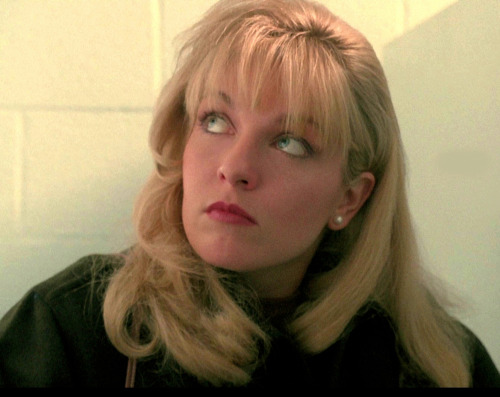
Laura
beardsftw: meowemy: Isn't he perfect? [[ Follow BeardsFTW!...

Isn't he perfect?
men I like
sagansense: "Behold! The Dinosaurs!" by Dustin Harbin on...
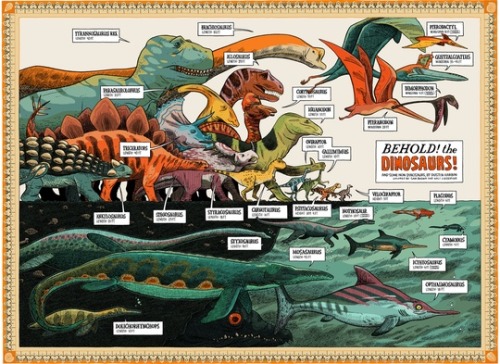
"Science does not deny religion. It just offers a simpler alternative."
"Science does not deny religion. It just offers a simpler alternative."- Stephen Hawking (via ikenbot)
sagansense: "This is the first confirmation of sedimentary...
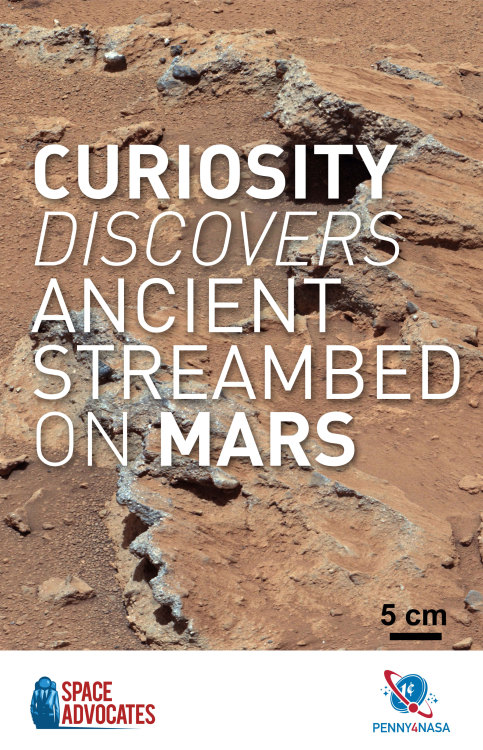
"This is the first confirmation of sedimentary conglomerates on another planet." - Rebecca M.E. Williams of the Planetary Science Institute.
NASA's Curiosity rover found evidence of exposed bedrock made up of smaller fragments cemented together, commonly referred to by geologists as a sedimentary conglomerate. These rocks are the first ever found on Mars that contain streambed gravels.
"These conglomerates look amazingly like streambed deposits on Earth," Williams added. "Most people are familiar with rounded river pebbles. Maybe you've picked up a smoothed, round rock to skip across the water. Seeing something so familiar on another world is exciting and also gratifying."
The size, shape, and arrangement of the rocks discovered by Curiosity display the telltale signs of water transport through a stream that potentially stretched for a few miles and likely was ankle-deep. Sanjeev Gupta, of the London-based Imperial College, added this:
"The rounding indicates sustained flow. It occurs as pebbles hit each other multiple times. This wasn't a one-off flow. It was sustained, certainly more than weeks or months, though we can't say exactly how long."
NASA plans to further explore the region where these conglomerates were located, known as the Gale Crater. This region has been identified to once have conditions that would be favorable for microbial life.
Check out this recent 360 degree panoromic of Mars from the "eyes" of Curiosity: http://www.360cities.net/image/mars-gigapixel-panorama-curiosity-solar-days-136-149#-5.92,-3.62,42.5
Read more about the Martian sedimentary conglomerates: http://www.nasa.gov/mission_pages/msl/news/msl20130530f.htmlvia pennyfournasa
sagansense: Heracleion Photos: Lost Egyptian City Revealed...
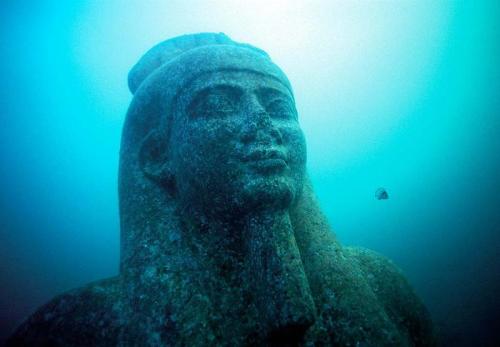
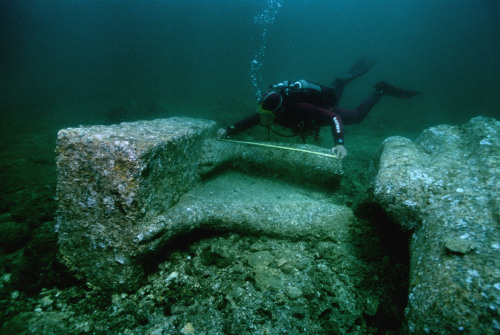

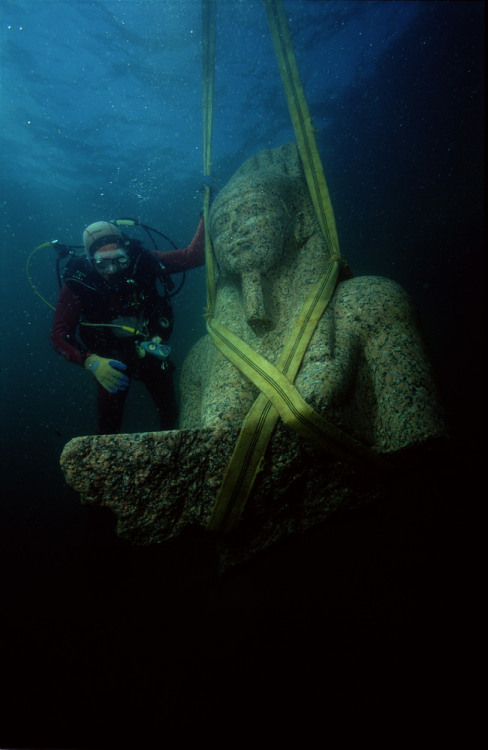
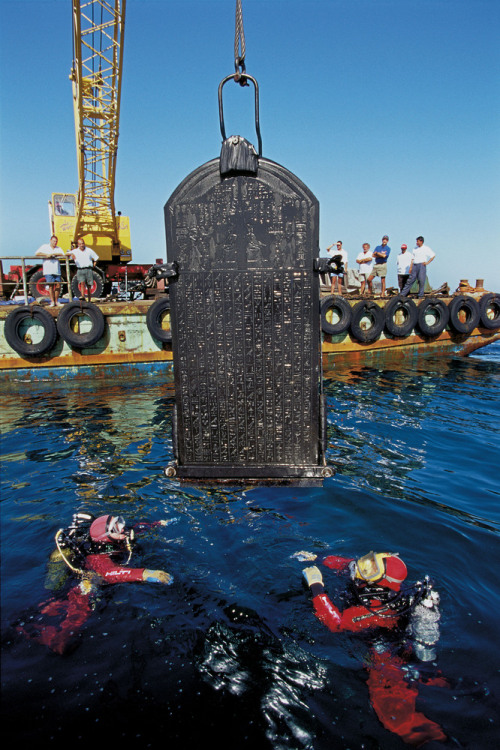
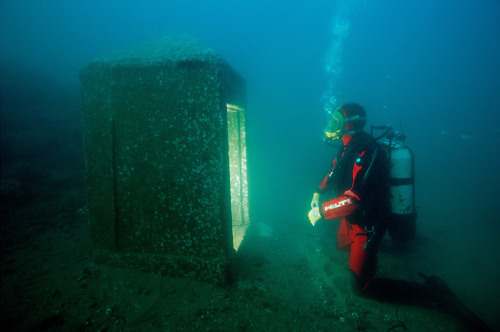
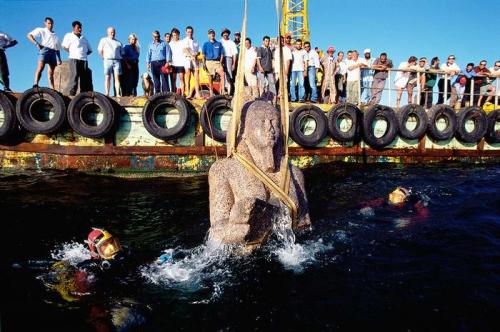
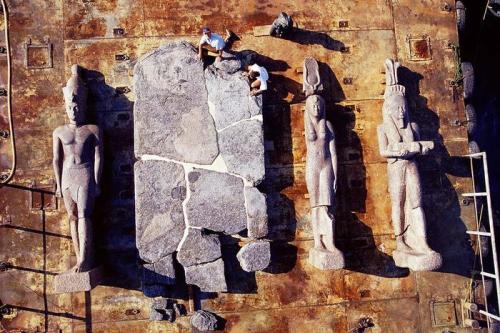

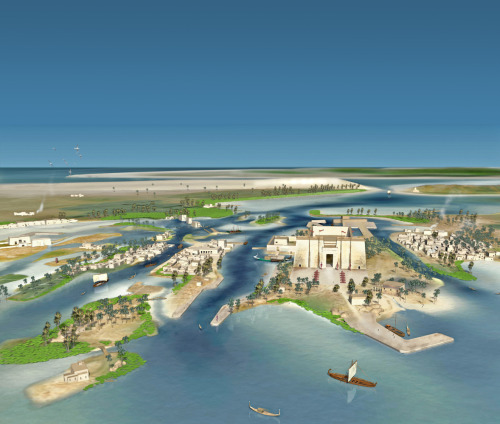
Heracleion Photos: Lost Egyptian City Revealed After 1,200 Years Under Sea
CNN Video [Breaking News]: Lost Egyptian City Revealed
It is a city shrouded in myth, swallowed by the Mediterranean Sea and buried in sand and mud for more than 1,200 years. But now archeologists are unearthing the mysteries of Heracleion, uncovering amazingly well-preserved artifacts that tell the story of a vibrant classical-era port.
Known as Heracleion to the ancient Greeks and Thonis to the ancient Eygptians, the city was rediscovered in 2000 by French underwater archaeologist Dr. Franck Goddio and a team from the European Institute for Underwater Acheology (IEASM) after a four-year geophysical survey. The ruins of the lost city were found 30 feet under the surface of the Mediterranean Sea in Aboukir Bay, near Alexandria.A new documentary highlights the major discoveries that have been unearthed at Thonis-Heracleion during a 13-year excavation. Exciting archeological finds help describe an ancient city that was not only a vital international trade hub but possibly an important religious center. The television crew used archeological survey data to construct a computer model of the city (above, last image).
According to the Telegraph, leading research now suggests that Thonis-Heracleion served as a mandatory port of entry for trade between the Mediterranean and the Nile.
So far, 64 ancient shipwrecks and more than 700 anchors have been unearthed from the mud of the bay, the news outlet notes. Other findings include gold coins, weights from Athens (which have never before been found at an Egyptian site) and giant tablets inscribed in ancient Greek and ancient Egyptian. Researchers think that these artifacts point to the city's prominence as a bustling trade hub.
Researchers have also uncovered a variety of religious artifacts in the sunken city, including 16-foot stone sculptures thought to have adorned the city's central temple and limestone sarcophagi that are believed to have contained mummified animals.
For more photos, visit Goddio's Heracleion website.
Experts have marveled at the variety of artifacts found and have been equally impressed by how well preserved they are.
"The archaeological evidence is simply overwhelming," Professor Sir Barry Cunliffe, a University of Oxford archeologist taking part in the excavation, said in a press release obtained by The Huffington Post. "By lying untouched and protected by sand on the sea floor for centuries they are brilliantly preserved."
A panel of experts presented their findings at an Oxford University conference on the Thonis-Heracleion excavation earlier this year.
But despite all the excitement over the excavation, one mystery about Thonis-Heracleion remains largely unsolved: Why exactly did it sink? Goddio's team suggests the weight of large buildings on the region's water-logged clay and sand soil may have caused the city to sink in the wake of an earthquake.
WATCH: Colossal Sunken Statues Of Thonis-Heracleion
PHOTO GALLERY: Lost city of Heracleion
From Legend to Reality
Thonis-Heracleion (the Egyptian and Greek names of the city) is a city lost between legend and reality. Before the foundation of Alexandria in 331 BC, the city knew glorious times as the obligatory port of entry to Egypt for all ships coming from the Greek world. It had also a religious importance because of the temple of Amun, which played an important role in rites associated with dynasty continuity. The city was founded probably around the 8th century BC, underwent diverse natural catastrophes, and finally sunk entirely into the depths of the Mediterranean in the 8th century AD.Prior to its discovery in 2000 by the IEASM, no trace of Thonis-Heracleion had been found. Its name was almost razed from the memory of mankind, only preserved in ancient classic texts and rare inscriptions found on land by archaeologists. The Greek historian Herodotus (5th century BC) tells us of a great temple that was built where the famous hero Herakles first set foot on to Egypt. He also reports of Helen's visit to Heracleion with her lover Paris before the Trojan War. More than four centuries after Herodotus' visit to Egypt, the geographer Strabo observed that the city of Heracleion, which possessed the temple of Herakles, is located straight to the east of Canopus at the mouth of the Canopic branch of the River Nile.
The Discovery
With his unique survey-based approach that utilises the most sophisticated technical equipment, Franck Goddio and his team from the IEASM, in cooperation with the Egyptian Supreme Council of Antiquities, were able to locate, map and excavate parts of the city of Thonis-Heracleion, which lies 6.5 kilometres off today's coastline. The city is located within an overall research area of 11 by 15 kilometres in the western part of Aboukir Bay. Franck Goddio has found important information on the ancient landmarks of Thonis-Heracleion, such as the grand temple of Amun and his son Khonsou (Herakles for the Greeks), the harbours that once controlled all trade into Egypt, and the daily life of its inhabitants. He has also solved a historic enigma that has puzzled Egyptologists over the years: the archaeological material has revealed that Heracleion and Thonis were in fact one and the same city with two names; Heracleion being the name of the city for the Greeks and Thonis for the Egyptians.The objects recovered from the excavations illustrate the cities' beauty and glory, the magnificence of their grand temples and the abundance of historic evidence: colossal statues, inscriptions and architectural elements, jewellery and coins, ritual objects and ceramics - a civilization frozen in time.
The quantity and quality of the archaeological material excavated from the site of Thonis-Heracleion show that this city had known a time of opulence and a peak in its occupation from the 6th to the 4th century BC. This is readily seen in the large quantity of coins and ceramics dated to this period.
The port of Thonis-Heracleion had numerous large basins and functioned as a hub of international trade. The intense activity in the port fostered the city's prosperity. More than seven hundred ancient anchors of various forms and over 60 wrecks dating from the 6th to the 2nd century BC are also an eloquent testimony to the intensity of maritime activity here.
The city extended all around the temple and a network of canals in and around the city must have given it a lake dwelling appearance. On the islands and islets dwellings and secondary sanctuaries were located. Excavations here have revealed beautiful archaeological material such as bronze statuettes. On the north side of the temple to Herakles, a grand canal flowed through the city from east to west and connected the port basins with a lake to the west.
—————————————————————
This is absolutely breathtaking. I'm literally speechless with chills from this video footage and photos. If anyone can find the documentary on this (in English, please), send it my way because I'd love to immerse myself in this excavation. The documentary is titled 'Egypt's Sunken City: A Legend Is Revealed'. So far, this is all Franck Goddio's team has published as far as I know; yet, the documentary was produced by the Discovery Channel, so it has to be out there somewhere. Science team…assemmmmmmble…
sagansense: Heracleion: More Excavation Photos From The...


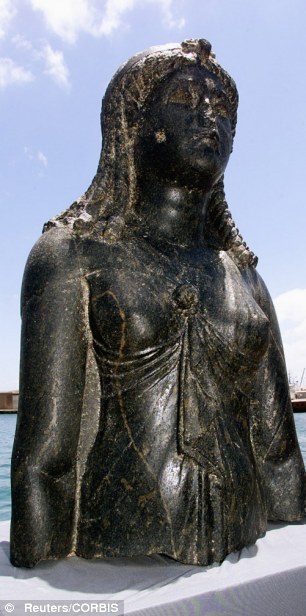
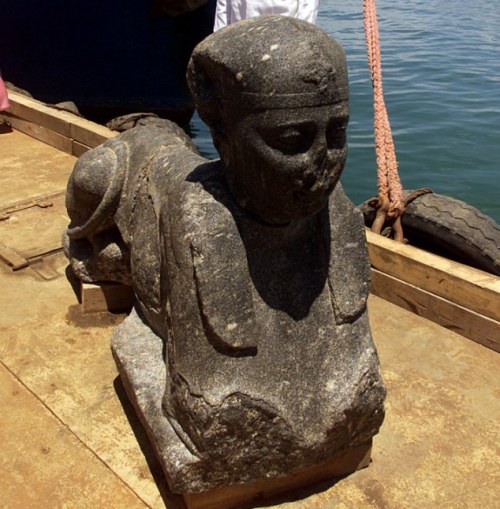
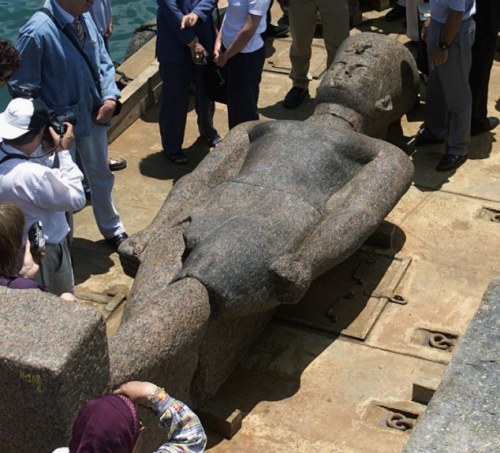
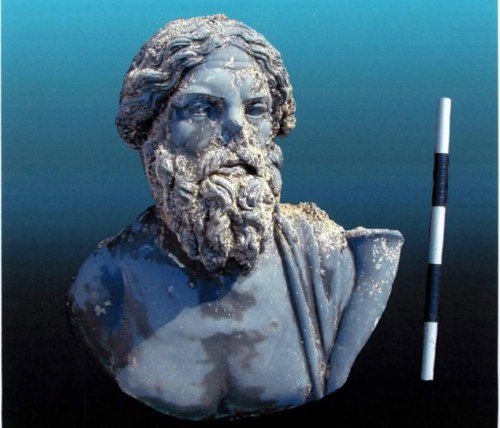
Heracleion: More Excavation Photos From The Depths
1: Secrets of the sea: Three divers inspect the ancient colossal statue of Hapi, the god of the Nile, at the site of the sunken city of Heracleion
2 & 3: Uncovered: Marine archaeologist Frank Goddio shows a stone slap from Heracleion (left) next to a statue of the Egyptian goddess Isis, found in the sunken city (right)
4: Ancient: A sphinx from Heracleion has been brought up from its resting place in the Bay of Aboukir
5: Hidden treasure: One of the 16ft statues found in the underwater ruins of Heraclion off the coast of Egypt, depicting an unknown Pharaoh
6: Historical: A bust found in the mud along the remains of Heraclion which sunk under the Mediterranean sea over 1,000 years ago
+ City of Heracleion sunk into the Mediterranean sea 1,200 years ago
+ Believed to be a legend until it was discovered by accident in 2001
+ New 3D maps shows what the city looked like shortly before it sankThe city of Heracleion, home of the temple where Cleopatra was inaugurated, was one of the most important trade centres in the Mediterranean area before it disappeared into what is now the Bay of Aboukir.
Heracleion was discovered in 2001, and after more than a decade of excavation, researchers have now been able to create a map depicting life in the ancient trade hub.
For centuries, Heracleion was believed to be a legend, much like the fabled city of Atlantis.
But 12 years ago, underwater archaeologist Dr Franck Goddio was searching the Egyptian coastline for French warships from the 18th century battle of the Nile, but instead stumbled across the treasures of the lost city.
After removing layers of sand and mud, divers discovered evidence of extraordinary wealth, painting a picture of what life was like in Heracleion, believed to have been at the centre of Mediterranean trade more than 1,000 years ago.
Archaeologists have found remains of more than 64 ships, buried in the seabed four miles off the coast of Egypt, the largest number of ancient ships ever to be found in one place.
As well as 700 anchors, the team have dug up gold coins and weights made from bronze and stone which would have been used in trade and to calculate taxation rates.
'The site has amazing preservation,' Dr Damian Robinson, director of the Oxford Centre for Maritime Archaeology at the University of Oxford, told the Telegraph.
'We are getting a rich picture of things like the trade that was going on there and the nature of the maritime economy in the Egyptian late period…There were things were coming in from Greece and the Phoenicians.'
The international research team have also discovered remnants of the legendary temple of Amun-Gereb where Cleopatra was invested with the power to rule Egypt.
The temple was the centre point of Heracleion from which a Venetian web of canals and channels connected other parts of the city together.
Giant 16ft statues have been reassembled on the seabed 150ft below the surface before being brought ashore, as well as hundreds of smaller statues of Egyptian gods.
Other finds include stone blocks with both Greek and Ancient Egyptian inscriptions and dozens of sarcophagi believed to have contained mummified animals offered as sacrifices to Amun-Gereb.
The research team, led by Dr Goddio have yet to establish what cause the city to go down, but the main theory is that the unstable sediments Heracleion was built on collapsed, and in combination with a rising sea-levels, may have caused the entire area to drop 12 feet straight into the water.
'We are just at the beginning of our research…'We will probably have to continue working for the next 200 years.'
Watch: Underwater excavation site (video)
notpulpcovers: The Bat Men Of Mars Air Wonder Stories, May...
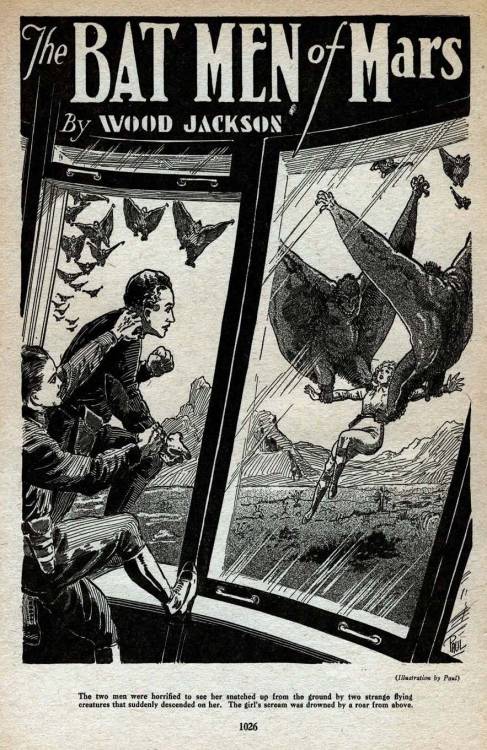
The Bat Men Of Mars
Air Wonder Stories, May 1930, illustration by Frank R. Paul
Photo



men I like
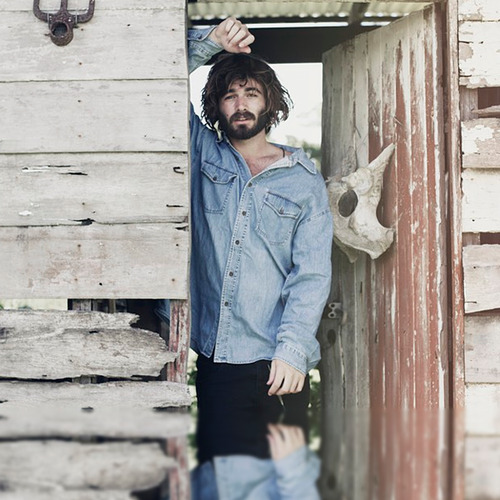
men I like
fuckyeahmovieposters: Europa Report
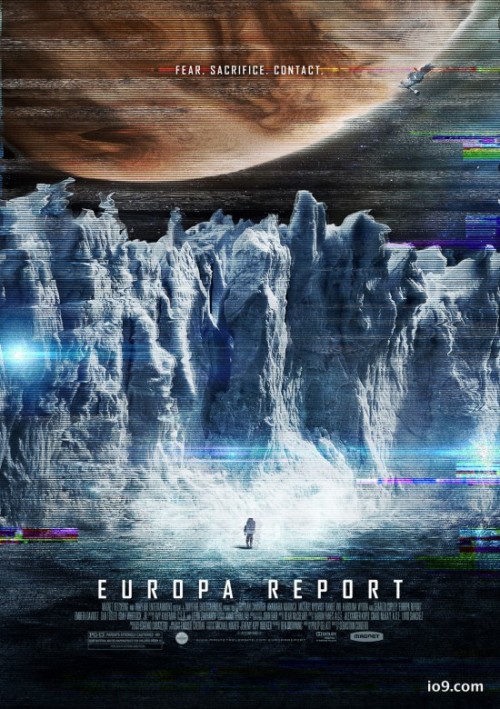
I´ve just updated my site with new works...

I´ve just updated my site with new works …enjoy!
http://ig-studio.com/
http://ig-studio.com/
http://ig-studio.com/
site - facebook - tumblr - blogger - twitter - deviant
space-alice: Sandworms of Dune by John Schoenherr (oil on...
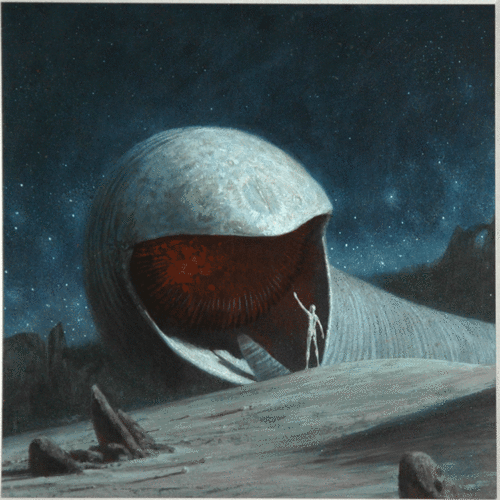
Sandworms of Dune by John Schoenherr (oil on masonite, 1977)
Man of Steel - Official Nokia Exclusive Trailer [HD] (by nokia)
Man of Steel - Official Nokia Exclusive Trailer [HD] (by nokia)
vodkapower: Maria Felix - Diego Rivera.

Maria Felix - Diego Rivera.
Pet Shop Boys - Axis (by PetShopBoysVEVO)
Pet Shop Boys - Axis (by PetShopBoysVEVO)














No hay comentarios:
Publicar un comentario